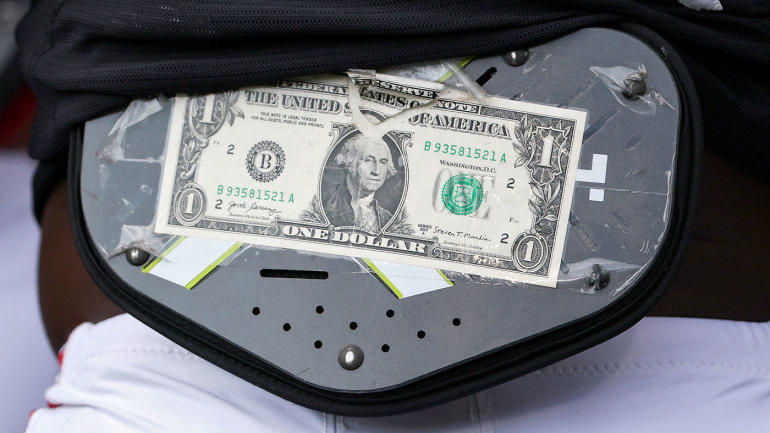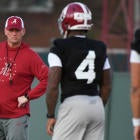
The conversation -- a notably preliminary one -- took place in December 2022. Around a table were venture capitalists and private equity types. The super-rich don't get that way sitting on their assets. They plan. They innovate. They create change; they don't wait for it.
So, at some point in the conversation, the question was posed: What would it take to "buy" a conference, invest at the base level of college athletics itself?
After some noodling, they agreed: $1 billion.
There's even a conference out there that would be available. You haven't heard of it. Nobody has.
It resides in the mind of media consultant Patrick Crakes. He was the one speaking with those investors who are beginning to see great potential in reshaping college athletics.
"Take $1 billion and roll up all the best teams into a new conference," said Crakes, who spent a quarter century as an executive at Fox Sports. "The best ones you can find who will go. Four or five from the Pac-12. Four or five Big 12 schools. Four or five from the ACC. Maybe there's a Big Ten or two that comes. You've got a conference."
All of it is brainstorm residue for now, the stuff pipe dreams are made of. Perhaps not actionable for 3-5 years but a glimpse at the biggest problem in the ongoing realignment discussion: how to stay relevant.
Crakes says there are only handful of persons in the country with the means and interest to strike such a deal. Not because they're the richest. This would be a unique investment with a million working parts. There would have to be a motivation as well: unique, unprecedented ownership.
The mere fact that it's being discussed -- even in a precursory manner -- offers a peek into the future. College athletics has always been a closed loop. Sure, there are sponsors and NIL, but all of that revolves around a (mostly) for-profit athletic department model married in at least a minor way with an educational model.
This sort of deal would not only mean third-party influence in college athletics but third-party ownership.
Since pursuit of this story began, CBS Sports has learned that at least one major private equity firm has shown interest in funding a conference structure.
"Things like the Big 12 and Pac-12 merging and taking parts of the ACC with them suddenly becomes something a private equity firm might say, 'Here's $1 billion to break all the contracts and make that happen,'" Crakes said. "I actually pitched that idea to a couple of people, and they all said, 'That is a great freaking idea, but we can't get our arms around that right now.' It was people who had the money to do it."
Crakes estimates it would take $500 million-$750 million to buy out ACC contracts for the likes of Clemson, Florida State and Miami. That answers part of the question about how those schools could extricate themselves from the ACC's ironclad deal.
It adds to a growing trend of outside investment. Disney CEO Bob Iger shook up the media world in July when he told CNBC that his company may sell equity stakes in ESPN. A subsequent report said ESPN could actually partner with the leagues they cover.
Fortune Magazine called the growing number of sports equity investors/owners "alt execs." Mets owner Steve Cohen is CEO of hedge fund Point72 Ventures. New Washington Commanders owner Josh Harris, co-founder of Apollo Global Management, led a group that paid a record $6 billion for the franchise.
In the most famous recent example, Saudi Arabia's Public Investment Fund successfully worked its way into the top level of professional golf by striking a previously unforeseen agreement with the PGA Tour.
They come armed with the experience to transition from traditional investing to sports. From 1995-2020, private equity funds produced an annual average return of more than 14%, according to Fortune. That looks good in any 401K.
In that sense, former Pac-12 commissioner Larry Scott was prescient. Almost five years ago, Scott pitched the idea of selling a 10% equity stake in the conference to private investors. A deal never emerged.
Not much has changed in the conference space race these days. The basic idea is to remain inside whatever exclusive club the FBS becomes. You can already see evidence of that creeping consolidation and the exclusivity that goes with it.
The perception is that the Big Ten and SEC are in the process of monopolizing the top of the sport with a pair of 16-team super conferences that include the best rivalries, best TV deals and most of the power -- athletically and financially. An AFC vs. NFC comparison has been made with the mega giants each sporting their own networks.
It would be more than a coincidence if the Big 12 also expands to 16 teams. That would make it an even 48 for those leagues, all three conferences with new media rights deals basically synced to expire at similar dates in the next decade.
Any combination of teams that keeps the Big Ten and SEC from disappearing over the horizon is a win at this point. Big Ten schools, at the back end of their new media rights deal, may be making $100 million annually (including bowl, College Football Playoff and NCAA Tournament revenue). The SEC could be at $80 million. Big 12 sources said their all-in figure will come close to $50 million.
Survival below that level may depend on some version of Crakes' vision.
"You hire somebody who can assemble a team who can go get this executed," Crakes said. "To get the $1 billion, you've got to have it first. There's a list of 15-20 people like that. None of those people ever get hired (as commissioners).
"When are we going to know when somebody is serious? When one of these 20 people gets hired. That would be a big tell."
We're close as the job descriptions shift for commissioners. Five of the last seven Power Five commissioners have come from TV, entertainment or media backgrounds. This counts new Notre Dame athletic director Pete Bevacqua, a former NBC Sports chairman, as the Fighting Irish have a place on the CFP Board of Directors.
The likes of new Big Ten commissioner Tony Pettiti are no longer the outliers. He was a senior executive at CBS, ABC and NBC who helped program the NCAA Tournament and helped launch the Bowl Championship Series. Pettiti has 14 Emmys, starting the MLB Network before becoming MLB CEO.
"Obviously, their biggest investment is television, and Tony knows it better than any of the other commissioners," said Chuck Neinas, a former NCAA, TV and conference executive.
It starts with the College Football Playoff
The next demarcation point for realignment is the new CFP media rights deal. Some have valued the 12-team playoff at more than $2 billion annually. In the current agreement, each of the Power Five conferences get a base share of $80 million. It's hard to imagine the Big Ten and SEC agreeing to share revenue evently when they have the most, biggest brands. By far.
The expanded playoff is both a symbol of college athletics' excess and the glue that will keep the ship together. How the CFP's TV negotiations -- due to begin next year -- play out will further divide the haves and have nots. Meanwhile, at least for now, everyone has access.
"Once that playoff is in place and we've gone through more of this media distribution evolution, there will be a place for more realignment," Crakes said. "That's why you want to have your conference locked in."
The question is the timing of what might as well be called "The Big Flex" from the Big Ten and/or SEC -- the moment when one or both overtly assert their primacy over the rest of the sport. It could be in those negotiations. It could be sooner. SEC commissioner Greg Sankey has reminded anyone who wants to listen on several occasions his league could stage its own playoff.
"The big next issue is, can we keep the perception of college athletics as involving all of us," outgoing Notre Dame AD Jack Swarbrick told Sports Illustrated, "or does the Big Ten and SEC become college athletics in terms of popular perception?"
A simple decision such as going to the 12 "best" teams in the playoff -- with no automatic qualifiers -- beginning in 2026 could have seismic consequences. In that scenario, it's easy to envision the Big Ten and SEC combining to take eight of the 12 spots. As it stands, the top six ranked conference champions and six at-large teams will make up the field beginning in 2024.
After the CFP is priced, the process for change should become more streamlined. There will conceivably be cash reserves making it possible to revenue share with players. Conferences left out in realignment may consider consolidating. That's when the investment houses get interested.
"At some point, you've got to have the conversation about revenue sharing," Kentucky coach Mark Stoops said. "Then we at least call it the way it is; we put [the players] under contract. too. You talk about coaches doing what they want to do. Well, they have contracts. Let's put college kids on contracts. Let's revenue share."
Will true leadership emerge?
Speaking of that "big tell," it's fair to say Sankey has become disillusioned with NCAA leadership. That was evident when he lashed out last month at the composition of the NCAA Board of Governors in the association's new constitution. The constitutional changes were sold as "streamlining" the NCAA, but Sankey -- speaking at the SEC spring meetings in early June -- offered a brief glimpse of his despairing view of the change.
The board went from 21 members to nine and included representatives of all three divisions.
"You're assigning all the legal and financial responsibility to a nine-member group that has a minority representation from the groups that are generating the financial and legal realities," Sankey said. "It really is backwards."
It's easy to read the code embedded there: The Power Five should have more control of the NCAA. That includes deciding not only how to spend the money but how much of it should be spent on legal issues.
In other words, for all intents and purposes, the NCAA is the Power Five. At least until the Big Ten and SEC decide to become a Power Two.
"That's our world," Sankey said of the power conferences' influence. "To assign decision-making authority to a room that is not invested the same way is long-term problematic. That's as direct and blunt as I could be."
Sankey has publicly stated his disappointment about the lack of feedback from the NCAA Council after an NIL presentation in late June. It did not end there.
"I've been in meetings in the old board where members of the board were provided a briefing I'd heard 50 times," Sankey said. "They said, 'I had no idea.' That can't happen at this time on boards of the NCAA, on any division or Board of Governors."
It's not surprising, then, in this transactional age of college sports, to imagine the concept of third-party ownership/influence. That thought has crossed the mind of CBS Sports college football analyst Gary Danielson.
"Just because it might be fun to do this," Danielson told CBS Sports. "If Mat Ishbia doesn't buy the Phoenix Suns, he buys Michigan State Spartans."
Ishbia, a former Spartans basketball player who sat at the end of Tom Izzo's bench, recently purchased the Suns. Before that, though, he and another monied booster funded the 10-year, $95 million contract of MSU football coach Mel Tucker.
"So, what is going to happen if somebody wants to just buy a college team?" Danielson asked rhetorically. "What would it take? Twenty-five million a year, and in three years, you'd win the national championship? It's like a big shadow sitting out there. It won't be a huge deal if it's Ohio State or Alabama or LSU or USC that does it. But what if this guy decides to do it at South Florida, or, 'I live in Boise. I want Boise to be the national champion. I've got $8 billion.'"
The biggest issue in any such model is return on investment. Is ROI in college sports measured in championships won, dollars earned or both?
More than 2 ½ years ago, the Knight Commission called for FBS to separate from the NCAA. In 2021, Ohio State AD Gene Smith suggested the CFP take over the FBS.
In a sports media rights world where the flow of money is drying up, the new Power Two will get most of the attention and revenue. If the Big Ten and/or SEC want to enter into a collective bargaining agreement with players, they could. If they wanted to carve out a piece of their massive rights fees to finance that endeavor, they could do that as well.
That alone could be an indicator of The Big Flex. What's the NCAA or CFP going to do ... kick them out?
"I wish there was a way for us to have more collaboration [with the SEC], but we are restricted legally … to come together and collaborate," Smith told CBS Sports. "We can't collude on the financial model."
As it stands, the Power Five basically allow the basketball tournament revenue -- a large part of it they produce -- to be shared among the 362 Division I schools. In return, the NCAA performs the regulatory functions of major-college football, a sport for which it doesn't sponsor a championship. That includes assuming sometimes-massive legal liabilities in form of lawsuits over injuries.
It's not so much the money the NCAA spends to run the FBS -- about $65 million annually -- it's about that liability, which accounts for approximately $10 million of that total. In some years, those legal fees can skyrocket depending on court costs and case settlements.
That's a quid-pro-quo relationship you won't read about in any document.
"The Autonomy Five said, 'We're going to let all of you share in all of our basketball money, so leave us alone on the football question,'" shared a Division I commissioner who spoke with CBS Sports under the condition of anonymity. "I've gotten the lectures from all of [the power conference commissioners]."
A continually changing landscape
The collegiate model itself has been shifting before our eyes for a while. Instead of speculating on the process -- what teams are going where?! -- why not own the process? Instead of evaluating the value of teams switching conferences, just buy the conferences themselves.
If that sounds radical, get used to it. Slightly more than a year ago, no one would have conceived of USC and UCLA moving across the country to join the Big Ten.
Big 12 commissioner Brett Yormark has snagged Colorado from the Pac-12 and may be poised to bring in more teams. Part of the plan is to look eight years ahead when the conference's new media rights deal (beginning in 2025) expires in 2031.
UConn basketball's worth to the Big 12 is obvious. UConn football is struggling, but it would benefit just by playing in the Big 12. Yormark sees a sort of a buy low, sell high concept. In some ways, UConn is relevant in New York, which remains the media center of the world. Yormark made his mark in New York's sports business world.
Think of UConn, then, as a speculative stock. You get in on the bottom floor of a lower-profile investment. Someday, it might pay off. UConn currently earns $4 million per year from the Big East. New Big 12 entries BYU, Cincinnati, Houston and UCF are making $18 million each in 2023. UConn's administration is said to be all in for the move.
Major college athletics' major flaw is a lack of vision. It sits by and lets things happen. The transfer portal and NIL exist because the NCAA obstructed, fought and delayed before finally being forced to make moves. It was that or face a withering number of lawsuits. Now, the association wants a bailout from Congress in the form of a federal NIL law.
Senate Minority Leader Mitch McConnell, R-Ky., might have summed it up recently: "The problem is if [the NCAA and its constituents] don't come behind a particular proposal, we'll screw it up going through the legislative process. What I've said to them repeatedly is, 'Before we can act, we have to know what you want.'"
Washington State president Kirk Schulz has seen that lack of vision up close.
"What happened is [the NCAA] got so involved with litigation they said, 'We're going to fight to the end,' [instead of saying], 'OK, where are we going to be five years?'"
Late SEC commissioner Mike Slive always said anything over 14 teams would make a conference more of an athletic association where relationships and the mission are diluted. We have proof. The only other 16-team FBS conference imploded amid travel logistics, infighting and money disputes.
Whatever the case, all of it is an indication of college sports becoming decentralized. The NCAA will have to share power. Sankey's comments certainly indicate that. The result is consolidation, like any business struggling to figure its future.
Maybe all of this should have been predicted almost 40 years ago when the NCAA lost a landmark Supreme Court case. In 1984, the NCAA saw its exclusive iron grip on college football telecasts loosen. Once on the open market, those games became more valuable. That has been reflected in burgeoning media rights deals.
Now, geography doesn't matter. The Big Ten is about to schlep USC and UCLA athletes 3,000 miles over three time zones. The Big 12 is attempting to be the first Power Five conference with teams in four time zones.
Venture capital opportunity awaits. Realignment may just be starting.
"We need to get things settled down and locked down to get through this next half decade of complete freakin' turmoil," Crakes said.





















